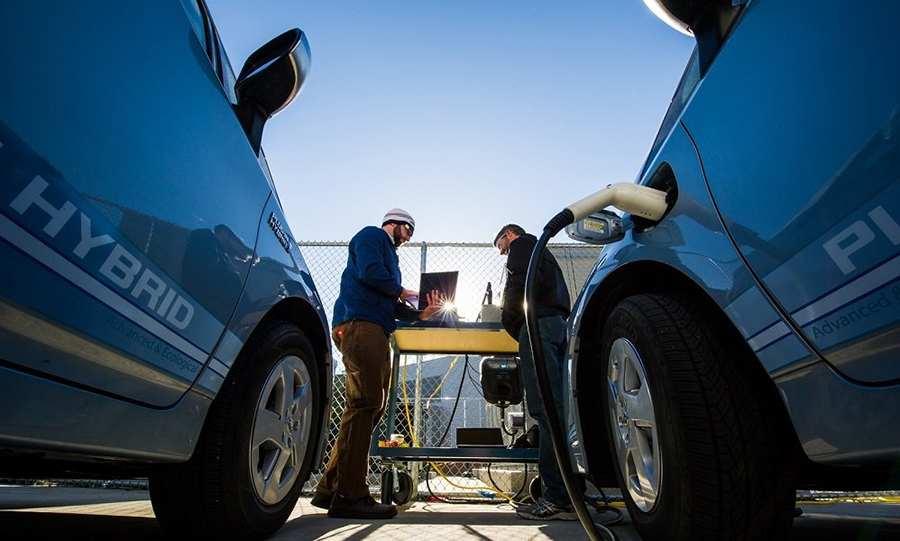Through the U.S. Department of Energy (DOE), the Biden-Harris Administration announced funding to accelerate the creation of zero-emission vehicle corridors to expand the nation’s electric vehicle (EV) charging infrastructure.
The Department has awarded $7.4 million to seven projects to develop medium- and heavy-duty electric vehicle (EV) charging and hydrogen corridor infrastructure plans to benefit millions of drivers in 23 states.
In addition, in coordination with the U.S. Department of Transportation through the Joint Office of Energy and Transportation, DOE announced its intention to release funds to address barriers to a cleaner, safer, more affordable, and more reliable Made in America EV zero-emission vehicle corridors.
President Biden’s goals
In coordination with other clean transportation announcements from the Federal Highway Administration and the White House, these funding measures will be critical to achieving President Biden’s goals of creating a national network of 500,000 EV chargers and ensuring that 50% of new light-duty vehicle sales are electric by 2030.
“A clean transportation sector requires major investments across the industry, including decarbonizing the trucks that carry our goods and building more charging ports to get those trucks from coast to coast,” said U.S. Energy Secretary Jennifer M. Granholm.
“President Biden’s historic clean energy laws are making it possible for us to put more zero-emission vehicle corridors on the road by expanding charging infrastructure in underserved communities while reducing range and cost anxiety among drivers who want to go electric,” the Secretary commented.
Zero Emission Freight Corridor Planning Selections
The DOE-funded projects will focus on electrification plans for essential and heavily trafficked national freight corridors, including those serving Northern and Southern California, the East Coast, the Northeast, the Southwest, and much of the Midwest.
The projects, managed by DOE’s Vehicle Technologies Office (VTO) and Hydrogen and Fuel Cell Technologies Office (HFTO), will advance the President’s decarbonization goals. Accelerating the deployment of medium- and heavy-duty electric vehicle charging and refueling infrastructure to reduce emissions from freight corridors and the depots, ports, and other facilities served by those corridors.
The selected projects support DOE’s Justice40 priorities by demonstrating the impacts and benefits of these freight corridor plans in underserved communities. The projects will also contribute to improving air quality in disadvantaged areas of major U.S. cities such as:
- New York,
- Los Angeles,
- Houston,
- Chicago,
- San Francisco,
- Oakland,
- and Salt Lake City.
The selected projects are:
CALSTART: East Coast ZEV Commercial Corridor. This project will launch an intensive strategic planning effort to stimulate the deployment of medium- and heavy-duty (MHD) zero-emission vehicle (ZEV) commercial infrastructure by developing an East Coast ZEV commercial corridor along the I-95 freight corridor from Georgia to New Jersey.
Cummins Inc: ZEV MD-HD infrastructure planning focused on the I-80 Midwest corridor. This project will develop a comprehensive two-phase MD-HD electric vehicle charging and H2 refueling plan for the I-80 Midwest corridor serving Indiana, Illinois, and Ohio, with the goal of 30% of the MD-HD fleet using ZEV technologies by 2035.
GTI Energy: Houston to Los Angeles (H2LA)-I-10 Hydrogen Corridor Project. This project will develop a flexible and scalable plan for an investment-ready heavy-duty truck and hydrogen fueling network from Houston to Los Angeles (H2LA) along I-10, including the Texas Triangle region, and develop a methodology for future corridor plans across the country.
Los Angeles Cleantech Incubator: From the First Mile to the Last Mile. Creating an Integrated Goods Movement Charging Network around the I-710 Corridor. This project will create a blueprint for innovative infrastructure solutions in industrial facilities. And commercial areas along critical freight arteries that feed the I-710 freeway in Southern California. The project will explore how private sector fleets can establish an integrated network that leverages existing industrial and commercial real estate assets while providing the most significant benefit to municipalities and communities.
It can be of your interest: Technical Assistance Partnerships driving industrial decarbonization
National Grid: Northeast Electric Highways Study. This project will forecast the demand for electric charging at traffic stops along freight corridors in:
- Maine,
- Massachusetts,
- New Hampshire,
- Vermont,
- Rhode Island,
- Connecticut,
- New York,
- Pennsylvania,
- and New Jersey
This to help develop a plan for the future large-scale deployment and lower cost of commercial electric vehicle charging. And serve as an example for other regions.
Rocky Mountain Institute: San Francisco and Bay Area Regional Roadmap for Medium and Heavy Vehicle Electrification. This project will create a roadmap for freight infrastructure to support the electrification. Of three key trucking market segments – freight, regional and long-haul – in the California Bay Area.
Utah State University: Wasatch Front Multimodal Corridor Electrification Plan – Greater Salt Lake City Region. This project will develop a community, state, and industry-supported action plan to improve air quality. All of this in underserved communities most impacted by medium and heavy high-density traffic in the Salt Lake City region.


